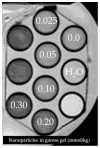Magnetic nanoparticles: surface effects and properties related to biomedicine applications
- PMID: 24232575
- PMCID: PMC3856004
- DOI: 10.3390/ijms141121266
Magnetic nanoparticles: surface effects and properties related to biomedicine applications
Abstract
Due to finite size effects, such as the high surface-to-volume ratio and different crystal structures, magnetic nanoparticles are found to exhibit interesting and considerably different magnetic properties than those found in their corresponding bulk materials. These nanoparticles can be synthesized in several ways (e.g., chemical and physical) with controllable sizes enabling their comparison to biological organisms from cells (10-100 μm), viruses, genes, down to proteins (3-50 nm). The optimization of the nanoparticles' size, size distribution, agglomeration, coating, and shapes along with their unique magnetic properties prompted the application of nanoparticles of this type in diverse fields. Biomedicine is one of these fields where intensive research is currently being conducted. In this review, we will discuss the magnetic properties of nanoparticles which are directly related to their applications in biomedicine. We will focus mainly on surface effects and ferrite nanoparticles, and on one diagnostic application of magnetic nanoparticles as magnetic resonance imaging contrast agents.
Figures








References
-
- Gubin S.P., Koksharov Y.A., Khomutov G.B., Yurkov G.Y. Magnetic nanoparticles: Preparation, structure and properties. Russ. Chem. Rev. 2005;74:489–520.
-
- Alberto P. Guimarães Principles of Nanomagnetism. Springer; Berlin/Heidelberg, Germany: 2009.
-
- Bertotti G. Hysterisis in Magnetism: For Physicists, Materials Scientists, and Engineers. Academic Press-Elsevier; Waltham, MA, USA: 1998.
-
- Frenkel J., Doefman J. Spontaneous and induced magnetisation in ferromagnetic bodies. Nature. 1930;126:274–275.
-
- Kittel C. Theory of the structure of ferromagnetic domains in films and small particles. Phys. Rev. 1946;70:965–971.
Publication types
MeSH terms
Substances
LinkOut - more resources
Full Text Sources
Other Literature Sources
Medical

